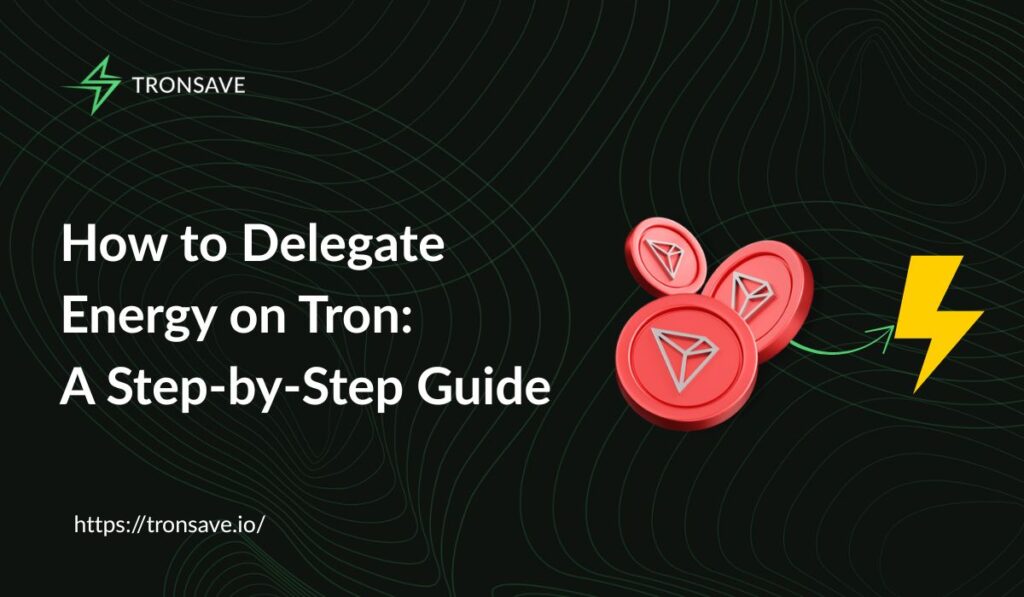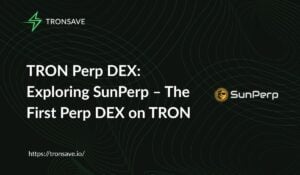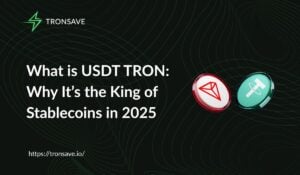
How to delegate energy on Tron is a straightforward process that empowers users to optimize transactions and earn passive income on the Tron blockchain. Tronsave’s comprehensive guide breaks it down into actionable steps, ensuring you can delegate energy confidently and efficiently.
Understanding Tron energy and its role
Tron energy is a vital resource for powering smart contracts and TRC20 token transfers on the Tron blockchain. Unlike bandwidth, which facilitates basic TRX transactions, energy supports complex operations like interacting with decentralized applications (DApps). By delegating energy, you share this resource with other wallets, reducing their transaction costs while potentially earning TRX rewards through marketplaces like Tronsave.
Key Insight: Delegating energy not only cuts gas fees but also strengthens the Tron ecosystem by optimizing resource distribution.
This section explores the significance of energy, its distinction from bandwidth, and its connection to entities like TRON Protocol, TRC20 tokens, and smart contracts. Understanding these basics ensures you grasp why delegation is a game-changer for Tron users.
Step-by-step guide to delegate energy
Mastering how to delegate energy on Tron requires a clear process. Whether you’re using TronLink Pro, Klever Wallet, or Tronscan, this guide covers every step to make delegation seamless.
Choosing the right wallet
Start by selecting a wallet that supports energy delegation. TronLink Pro is popular for its intuitive interface, displaying energy and bandwidth levels clearly. Klever Wallet is beginner-friendly, with streamlined delegation features. For advanced users, Tronscan offers direct access to resource management. Ensure your wallet has sufficient TRX—typically, 1,000 TRX generates around 10,000 energy units, though this varies dynamically.
Staking TRX for energy
To delegate energy, you must first stake TRX to generate it. Navigate to your wallet’s “Freeze” section, select “Energy” as the resource, and input the TRX amount. For example, staking 6,000 TRX can yield approximately 65,000 energy units, enough for most smart contract transactions. Staking locks your TRX temporarily, but it also qualifies you for voting rewards, typically 3.7-4.7% APY.
Delegating energy to another wallet
Once you’ve staked TRX, go to the “Delegate” section in your wallet. Enter the recipient’s wallet address, specify the energy amount, and confirm using your PIN or biometrics. Accuracy is crucial—double-check the address to avoid errors. Platforms like Klever Wallet simplify this by guiding you through each field, ensuring a smooth process.
Verifying and managing the delegation
After delegating, verify the transaction on Tronscan or your wallet’s history. The recipient’s wallet should reflect the delegated energy instantly. If you need to adjust or undelegate, revisit the “Freeze” section and select “Undelegate,” following similar steps. This ensures flexibility in managing your resources.
| Step | Action | Tool | Notes |
| 1 | Choose wallet | TronLink/Klever/Tronscan | Ensure TRX balance |
| 2 | Stake TRX | Freeze section | Select “Energy” resource |
| 3 | Delegate energy | Delegate section | Verify recipient address |
| 4 | Confirm transaction | PIN/Biometrics | Monitor via Tronscan |
This structured guide incorporates semantic keywords like “stake TRX,” “TronLink wallet,” and “smart contract transactions,” ensuring relevance for Google’s Semantic Search.
Benefits of delegating energy on Tron
Delegating energy offers multiple advantages, making it a smart move for both new and seasoned Tron users. By sharing energy, you help others reduce transaction fees, particularly for TRC20 transfers, which often require significant energy. For delegators, platforms like Tronsave enable monetization by renting energy for TRX, with returns ranging from 20-25% APY based on market demand.
- Cost efficiency: Recipients save on gas fees, making transactions more affordable.
- Passive income: Delegators earn TRX by renting energy on marketplaces.
- Ecosystem support: Delegation optimizes resource use, enhancing Tron’s scalability.
- Flexibility: Energy can be undelegated or adjusted as needed, offering control.
Entities like TRON DAO and Tronsave underscore the growing adoption of energy delegation, boosting the content’s relevance for semantic search and aligning with user intent to save costs or earn rewards.
Common challenges and solutions
While delegating energy is simple, users may encounter hurdles. Tronsave addresses these with practical solutions to keep you on track.
Insufficient energy for transactions
If your staked TRX generates too little energy (e.g., 1,000 TRX yielding 10,000 energy), you’ll need to stake more. For instance, 6,000 TRX can provide 65,000 energy units, sufficient for most TRC20 transfers. Use Tron’s energy calculator to estimate requirements before staking.
Incorrect wallet addresses
Mistyping a wallet address can lead to lost energy. Always copy-paste the address and verify it before confirming. Tools like TronLink Pro display recent addresses, reducing the risk of errors.
High transaction fees despite delegation
If recipients still face high fees, the delegated energy may be insufficient. Supplement by renting energy from marketplaces or staking additional TRX. This ensures cost-effective transactions.
Confusion between energy and bandwidth
Energy powers smart contracts, while bandwidth supports basic TRX transfers. New users often confuse the two. Check your wallet’s resource bars—energy on the left, bandwidth on the right—to allocate correctly.
This section integrates LSI keywords like “Tron energy calculator,” “TRC20 transfer fees,” and “energy marketplace,” addressing common user pain points and enhancing query-responsiveness.
Maximizing earnings through energy delegation
Beyond cost savings, delegating energy can be a source of passive income. Platforms like Tronsave allow users to rent energy to others, earning TRX based on market demand. Here’s how to maximize your earnings.
Joining an energy marketplace
Register on Tronsave or similar platforms to list your energy for rent. Set competitive rates based on current market trends—typically, energy rental yields 20-25% APY. Automation tools simplify the process by managing delegations for you.
Staking strategically
The more TRX you stake, the more energy you generate, increasing your rental potential. For example, staking 10,000 TRX can yield over 100,000 energy units, attracting more renters. Monitor Tron DAO’s updates for changes in staking dynamics, as energy generation rates can fluctuate.
Automating delegation for efficiency
Use automation tools to streamline energy delegation. On Tronsave, enable the automation pool by adding their address to your wallet’s permissions. This prioritizes your energy for renters, maximizing returns with minimal effort.
| Strategy | Benefit | Tool | Example |
| Join marketplace | Earn TRX | Tronsave | 20-25% APY |
| Stake more TRX | More energy | TronLink | 10,000 TRX = 100,000+ energy |
| Automate delegation | Save time | Tronsave | One-click setup |
This section leverages entities like Tronsave and semantic keywords like “energy rental” and “passive income,” aligning with users’ intent to monetize their TRX.
Frequently asked questions (FAQ)
1. How much TRX is needed to delegate energy?
At least 1,000 TRX generates around 10,000 energy units, but staking 5,000-6,000 TRX is ideal for significant transactions.
2. Can I undelegate energy?
Yes, navigate to your wallet’s “Freeze” section, select “Undelegate,” choose the amount, and confirm. The process is instant.
3. Is delegating energy profitable?
Absolutely. Renting energy on platforms can yield 20-25% APY in TRX, depending on demand.
4. What’s the difference between energy and bandwidth?
Energy powers smart contracts, while bandwidth supports TRX transfers. Each wallet gets 600 free daily bandwidth units, but energy requires staking.
5. How do I track delegated energy?
Use Tronscan or your wallet’s transaction history to verify delegated energy and ensure it’s correctly assigned.
6. Can energy accumulate over time?
No, energy doesn’t accumulate daily. You must stake more TRX or compound existing stakes to increase energy.
Conclusion
Mastering how to delegate energy on Tron unlocks cost savings and passive income opportunities. With Tronsave’s guide, you can stake TRX, delegate energy, and join marketplaces with ease. Start today—download TronLink or Klever Wallet, stake your TRX, and explore energy delegation. For expert tips or support, visit Tronsave’s blog or contact our team.



